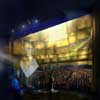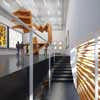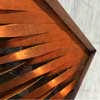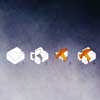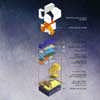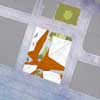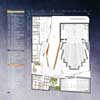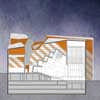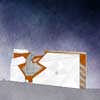House of Arts and Culture Beirut, Lebanon Building, Project, News, Image, Design
House of Arts and Culture Beirut by Kaputt!
Honourable Mention – Lebanese Competition Entry by Kaputt!
2 Apr 2009
The House of Arts and Culture – Entry
Beirut, Lebanon
2009-
Design: Kaputt!
HOUSE OF ARTS AND CULTURE
Kaputt! architects studio receives Honourable Mention at the “House of Arts
and Culture” international competition.
In its course and struggle to animate its great civilization, another step is taken: Beirut constructs its House of Arts and Culture. People from Beirut and the world will come to reflect upon and distance themselves from everyday life and, influenced by its extraordinary atmosphere, come together in the creation of art and culture. The House of Arts and Culture is a place of reunion and exchange. It is always free, open to all, yet shelters and protects. Like in the courtyard of a caravanserai, we will find a breathing inhabited space and through its transparency we feel its pulses. The exterior spaces, open to the outside, are both part of the city and the House itself. The House is designed with present technology but is independent of it, something bigger. Something adaptive. Change is its name. This is not an office building.
URBAN AND ARCHITECTURAL OBJECTIVES:
The project is designed from a single volume, a shell that at first occupies all the plot´s surface. From this shell, mass is removed around two perpendicular axes, thus, creating a cross-shaped void. The center of this void and the inside of the shell are structured by copper blades, generating four exterior spaces in the interior of the plot. At the end of this operation, the surface at ground floor level of the project takes 70% of the plot. The affirmative presence of the shell allows for the planned integration of the building within the urban grid planned for the location. Through the vegetation of the exterior spaces, one can see the copper blades on the interior facades. It is the difference of character of these two components, the peripheral shell in white concrete, heavy and compact, and the thin blades of copper, light and permeable, that define the project´s intention. Through the blades, one can see the fluidity of people throughout the whole building. The chosen materials will age and create a patina without changing their character, thereby, preserving the character of the whole building over time.
PERFORMANCE AND CONFERENCE HALL:
For the main auditorium we propose a fully equipped proscenium stage; the small auditorium will have a black box character with a technical ceiling and movable seats to enable a vast choice of configurations; the projection room is prepared to serve the National Cinematheque. Theatre, dance, acoustic concerts and oratories are some of the most likely performances; Cinema projection, live concerts, congresses, conferences, seminars, etc. where electroacoustics will dominate the scene, are alternative activities for these spaces. Acoustics suited for live recordings and broadcasting connect it to the rest of the world. Large Performance and Conference Hall: Its shape can be read from the main exterior space through the copper blades. From the staircase it will be seen in all its amplitude. Here, one can understand that the acoustical shell is free of the covering roof. The Large Performance and Conference Hall aspires to be as encompassing as possible. The Hall´s layout consists of a series of fanned radial sections, centered on the stage, forming an ellipsoid in its entirety. Multipurpose usage for the Large Performance and Conference Hall as music and theatre require very different room acoustic properties (opposite material characteristics), raising the need to use interior variable acoustics. A box-in-a-box solution (double structure) must be applied to the main structural concept design at least for the performance halls and the movie theatre. These measures will isolate the buildings from external sources of vibration and noise.
House of Arts and Culture Beirut – Project Team
ARCHITECTURAL COORDINATION:
Rita Ferreira, Kirill de Lancastre Jedenov
ARCHITECTS:
Sérgio Antunes, Irene Bonacchi, Ana Brütt, Sofia Reis Couto, Filipe Moreira, Manuel Ribeiro
EXTERNAL CONSULTANTS:
Filipe Alves (conceptual phase)
Luca Martinucci (atmosphere definer)
Mário Rui Marques Ferreira (structural engineering)
Rodrigo Tomaz, dBLab ( Architectural Acoustics)
Luís Paiva de Andrada (H.V.A.C. consultant)
Flavio Tirone, ARSUNA (theatre design consultants)
Eloísa Cepinha, SUSTENTARE (sustainability)
Isabel do Carmo (cultural history)
Roger Claustre (social history)
Alexandra Lucas Coelho (contemporary Lebanon)
One of eleven prized submissions, Lisbon-based architecture studio Kaputt! was
awarded a Honourable Mention. Kaputt! was founded in Lisbon in 2004 by eight
young architects. Please see the attachment for a short portfolio of Kaputt!
and an illustrated resume of the prize-winning design.
House of Arts and Culture Beirut : main page
House of Arts and Culture entry by Kaputt! – Text in Portuguese:
CASA DAS ARTES E DA CULTURA
Mais um passo dado, na evolução e grandiosidade da nossa Civilização: Beirute constrói a sua Casa das Artes e da Cultura. Pessoas de Beirute e do mundo virão reflectir e distanciar-se da vida quotidiana e, influenciadas pelo seu ambiente extraordinário, juntar-se na criação de obras únicas. A Casa das Artes e da Cultura é um lugar de encontro e troca, sempre aberto, que ao mesmo tempo abriga e protege como o pátio de um caravanserai. Os espaços exteriores, abertos para a rua, são ao mesmo tempo parte da cidade e a Casa em si. A Casa é desenhada com tecnologia actual mas é independente desta, é algo maior. Adaptável à mudança. Isto não é um edifício de escritórios.
OBJECTIVOS URBANOS E ARQUITECTÓNICOS
O projecto parte de um único volume, uma casca que inicialmente ocupa todo o lote. Desta casca, é retirada matéria à volta de dois eixos perpendiculares, criando assim um vazio em cruz. O centro deste vazio e o interior da casca, são estruturados por lâminas em cobre, gerando quatro espaços exteriores no interior do lote. No fim desta operação, a superfície do nível térreo ocupada pelo projecto é de 70% do lote. A presença assertiva da casca permite uma integração do edifício na malha urbana proposta para o sítio. Através da vegetação existente nos espaços exteriores, vêem-se as lâminas de cobre nas fachadas interiores. É o contrastre entre estes dois elementos, a casca periférica em betão branco, compacta e pesada, e as finas lâminas de cobre, leves e permeáveis, que define a intenção do projecto. Através das lâminas pode-se ver a fluidez de pessoas a passar, por todo o edifício. Os materiais escolhidos envelhecerão e criarão uma pátina sem alterarem as suas propriedades, preservando desta forma o carácter de todo o edifício através dos tempos.
CENTRO DE CONFERÊNCIAS E ESPECTÁCULOS
Para o auditório principal propôs-se um palco completo e equipado. O pequeno auditório terá um carácter de caixa negra com um tecto técnico e assentos móveis para permitir uma vasta escolha de configurações. A sala de projecção está preparada para servir a Cinemateca Nacional. Teatro, dança, concertos acústicos e palestras são alguns dos eventos mais comuns; Projecção de filmes, concertos ao vivo, congressos, conferências, seminários, são actividades alternativas para estes espaços. Uma acústica própria para gravações e radiodifusões ao vivo, liga a Casa das Artes e da Cultura ao resto do mundo. A forma correspondente ao Grande Centro de Conferências e Espectáculos pode ser lida do espaço exterior através das lâminas de cobre. Da escadaria será visto em toda a sua grandeza sendo perceptível que a casca acústica é independente da cobertura do edifício. O Grande Centro de Conferências e Espectáculos procura ser o mais envolvente possível. O seu layout consiste numa série de secções radiais em leque, centradas no palco, formando um elipsóide na sua totalidade.
Múltiplos usos para o Grande Centro de Conferências e Espectáculos como a música e o teatro requerem propriedades acústicas muito differentes (materiais com características opostas), elevando a necessidade de usar acústica interior variável. Uma solução “box-in-a-box” (estrutura dupla) terá de ser aplicada aos auditórios e ao cinema. Estas medidas isolarão o edifício de fontes exteriores de vibração e barulho.
Equipa de projecto:
Coordenação:
Rita Ferreira, Kirill de Lancastre Jedenov
Arquitectos:
Sérgio Antunes, Irene Bonacchi, Ana Brütt, Sofia Reis Couto, Filipe Moreira, Manuel Ribeiro
Consultores externos:
Filipe Alves (Fase conceptual)
Luca Martinucci (Criador de ambientes)
Mário Rui Marques Ferreira (Engenheiro de estruturas)
Rodrigo Tomaz, dBLab (Condicionamento Acústico)
Luís Paiva de Andrada (Consultor AVAC)
Flavio Tirone, ARSUNA (Consultoria e projecto cénico)
Eloísa Cepinha, Sustentare (Consultoria em sustentabilidade)
Isabel do Carmo (História cultural)
Roger Claustre (História social)
Alexandra Lucas Coelho (Líbano contemporâneo)
House of Arts and Culture Beirut entry images / information from Kaputt! 020409
Location:Beirut, Lebanon
Lebanese Buildings
Lebanon Architecture Designs : chronological list
Beirut Architecture Walking Tours
Jordan Architecture I Syrian Building I Israeli Developments
Portuguese Architect : Kaputt! contact details
Comments / photos for the House of Arts and Culture Beirut Architecture page welcome
House of Arts and Culture Beirut Building


